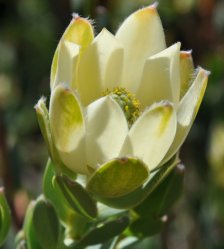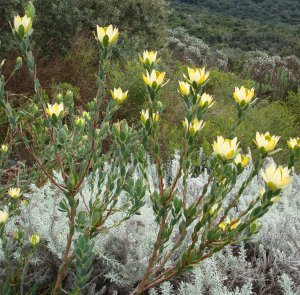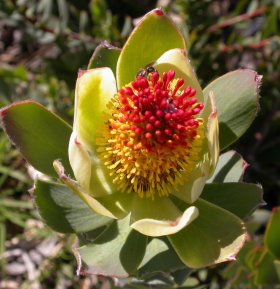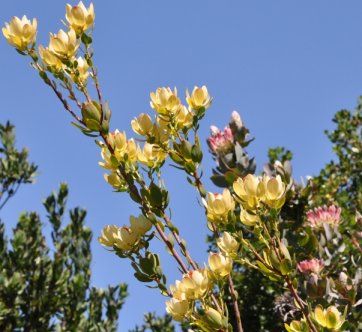Leucadendron discolor
Leucadendron discolor E.Phillips & Hutch.
Family: Proteaceae
Common names: Piketberg conebush, gold flame tips, red conebush (Eng.); rooi-tolbos (Afr.)
SA Tree No: 79
Introduction
For most of the year Leucadendron discolor is a grey-green filler, best planted towards the back of the shrubbery. During spring it comes alive with colour and adds a splash of bright yellow and red to the garden.

Description
Description
The juvenile phase of Leucadendron discolor is a small densely bushy shrub. A year or two after planting out it matures and gradually sends up long erect flowering shoots reaching an eventual height of 2 m and a spread of 1-1.5 m.
One of the distinguishing features of this Leucadendron are the grey-green broadly ovate leaves. Another, are the flowerheads which appear in spring. Male flowerheads are bright red and yellow surrounded by creamy yellow involucral leaves. Female plants form a grey-green cone surrounded by pale green involucral leaves that almost enclose the flowerhead.

Winged seeds are found inside the cone on the female plant. They ripen a few months after flowering and are retained on the plant.

Conservation Status
Status
Leucadendron discolor is listed as VU (Vulnerable) and the population is seen to be declining.
One of the threats is wild flower harvesting. Male plants are harvested for cut flowers leaving skewed population ratios of male to females. As sub-populations are small, this drastically affects pollination and seed production and therefore future generations.
Another threat is habitat loss due to expanding fruit and protea orchards. Coupled with encroaching protea orchards, is the threat of hybridization with other species of Leucadendron planted in the orchards.

Distribution and habitat
Distribution description
The Piketberg conebush grows on rocky, sandstone soils amongst mountain fynbos at altitudes between 450 -and 500 m. As its common name alludes, it is found only in the Piketberg Mountains.
Derivation of name and historical aspects
History
The Proteaceae family is large, consisting of about 1 400 species. The Leucadendron genus contains about 83 species; which, apart from 1 outlying species and 2 outlying subspecies, are all confined to the southern and southwestern part of the Western Cape.
The genus name is composed of leucos, meaning white and dendron, meaning tree. This refers to the iconic Silvertree (Leucadendron argenteum) on which the genus was based. Early Dutch settlers originally referred to the Silvertree as the Witteboom or 'White tree'.
Discolor means two colours and refers to the flowerhead on the male plant. It is bright red in bud, changing to sunshine yellow as the pollen appears.
Ecology
Ecology
The Piketberg conebush is pollinated by insects carrying pollen from the male flower onto the female cone. Pollination occurs and seeds form and grow within this cone. The cone remains tightly closed protecting the seeds from the weather and from being eaten by animals.
Plants are killed by fire. After a fire all the cones open to release the seed which drops to the ground, germinates and establishes a new population.

Uses
Use
Leucadendron discolor has been extensively used in producing hybrid plants for use as cut flowers. It has been crossed with L. salignum, L. conicum, L. laureolum and L. gandogeri, to name a few. Special forms have also been selected: 'Pom Pom', 'Green Cup', 'Rose Cup' and 'Yellow Cup'.

Growing Leucadendron discolor
Grow
Leucadendron discolor can be propagated from cuttings or seed. Sowing seed is the easier method and requires no specialist equipment. It also produces a more resilient and better shaped plant. Make cuttings if you have a mother plant with special features, e.g. darker red flowerheads than other plants. This is the only way to preserve these features. Cuttings tend to produce a plant with a shallower, weaker root system but if planted in a garden situation with regular watering this is not too much of a problem.
Make cuttings from December to March (summer to autumn). The cuttings should be semi-hardwood, 60-100 mm long, and taken from the current season's growth. Dip the cuttings into a rooting hormone solution or hormone powder and plant into a medium of 50% polystyrene and 50% finely milled pine bark. Place in a growing house with bottom heat (25ºC). Once the roots are well developed, remove from bottom heat and harden off for three weeks. Plant the cuttings into small bags and grow on until ready to plant into the garden.
Sow seed in April when the days are warm and the nights start to cool down (late summer to autumn). Dust the seed with a systemic fungicide. Sow on a well-drained medium, firm down and cover with a layer of sand or finely milled bark. Seed can be sown in an open seedbed, or in a seed tray placed in a sunny position. Germination begins after two to three weeks. Once two true leaves have grown, prick the seedlings out into small bags. Place the seedlings in a lightly shaded area with good air circulation. When plants are ± 50-100 mm tall, or after one year's growth, they can be planted into the garden.
Seed can also be sown directly where you want the plants to grow. Plant, cover lightly with soil and water.
The best time to place the young plants in the garden is at the start of the rainy season. This enables plants to establish themselves and send down deep roots before the hot, dry summer season. Leucadendron discolor requires a hot, sunny position with well-drained acidic soil. Add a scoop of welldecomposed compost at planting and water well for the first year.
Once members of the protea family become diseased they are very difficult to treat, and it is better to prevent disease, rather than try to cure it. Make sure your environmental conditions are correct. This includes getting direct sunlight for most of the day, a well-drained soil which does not stay saturated and will not stagnate, and good air circulation ensuring that the above-ground parts of the plant dry quickly after watering. It is also important to ensure that the soil stays cool in the hot months and that roots are not disturbed by digging. A thick layer of mulch or surrounding planting can be used to keep the soil cool and prevent moisture loss. If any of these factors are not correct, the plants become weakened and stressed, and you can be sure to attract some form of pest or disease.
References
- Matthews, L. 1993. Proteas of the world . Bok Books, Durban. Rebelo, A.G., Helme, N.A., Holmes, P.M., et al . 2009. Leucadendron discolor E.Phillips & Hutch. National Assessment: Red List of South African Plants version 2012.1. Accessed on 2012/09/07
- Rebelo, A. (Tony). 2001. Proteas. A field guide to the proteas of southern Africa , edn 2. Fernwood Press, Cape Town.
- Williams, I.J.M. 1972. A revision of the genus Leucadendron (Proteaceae). Contributions from the Bolus Herbarium 3. University of Cape Town.
Credits
Louise Nurrish
Kirstenbosch National Botanical Garden
September 2012
Plant Attributes:
Plant Type: Shrub
SA Distribution: Western Cape
Soil type: Sandy, Loam
Flowering season: Spring
PH: Acid, Neutral
Flower colour: Green, Red, Cream, Yellow
Aspect: Full Sun
Gardening skill: Average
Special Features:
Horticultural zones







Rate this article
Article well written and informative
Rate this plant
Is this an interesting plant?
Login to add your Comment
Back to topNot registered yet? Click here to register.